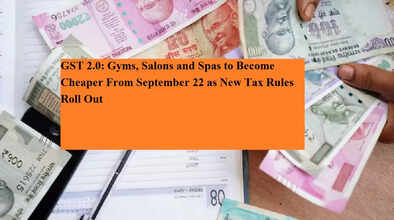GST 2.0: Gyms, Salons and Spas to Become Cheaper From September 22 as New Tax Rules Roll Out

A major tax reform is set to come into effect across India from September 22, 2025, as the government introduces GST 2.0, a simplified version of the Goods and Services Tax system. The new structure will directly impact everyday services such as gyms, salons, spas, and yoga classes, making them more affordable for consumers.
Lower GST Rate on Daily Lifestyle Services
Until now, most personal care and fitness services attracted an 18% GST. Under the revised structure, these services will now be taxed at only 5%, without the option of claiming input tax credit (ITC). For consumers, this change translates into lower membership fees and service bills, offering much-needed relief to households.
For example, if a gym membership previously cost ₹1,000 per month, customers ended up paying ₹1,180 after taxes. With GST 2.0, the same service will now cost only ₹1,050. Similarly, a salon service priced at ₹500, which earlier amounted to ₹590 after tax, will now be billed at ₹525. This reduction makes wellness and grooming services more accessible to the middle class and younger population.
Why the Change Was Introduced
According to Finance Minister Nirmala Sitharaman, the decision was taken to simplify the overall GST structure and remove unnecessary complications. Under the new system, there will primarily be two major tax slabs—5% and 18%. In addition, luxury goods and sin products will continue to attract a special tax rate of 40%.
The 12% and 28% slabs have been completely removed, thereby streamlining the system. The government believes that this move will not only reduce compliance burdens for businesses but also improve transparency in the taxation process.
How Consumers Will Benefit
For the average consumer, this reform will bring visible savings in routine spending. Fitness centers, yoga studios, beauty parlors, and spas—services that are becoming an integral part of urban lifestyles—will now cost less. The government has also pitched this as a kind of “Diwali gift” to the public, ensuring that the benefits of economic reform are felt directly in people’s wallets.
Beyond affordability, experts suggest that lower prices will encourage higher consumption of wellness and grooming services. This could boost demand across the sector, ultimately supporting small businesses, startups, and service providers who have been struggling with rising costs.
Benefits for Businesses
For business owners, GST 2.0 will bring a simplified tax filing process. By merging multiple slabs into just two, compliance is expected to become easier, reducing the chances of disputes and confusion. Although the removal of ITC may affect certain businesses, the overall lower tax burden is likely to balance the equation.
Industry leaders believe that this reform could revitalize the beauty and fitness industry, which has faced challenges in recent years due to inflation and high operating costs. With more people likely to return to gyms, salons, and wellness centers, the sector may see renewed growth.
Broader Economic Impact
From the government’s perspective, GST 2.0 is part of a larger strategy to simplify India’s tax regime, improve ease of doing business, and encourage consumption-led growth. Cheaper services could help control inflationary pressures, while increased consumer activity may stimulate the economy.
This dual benefit—making life easier for consumers while improving business efficiency—highlights why GST 2.0 is being hailed as one of the most significant tax reforms in recent years.
Bottom Line
From September 22, 2025, your monthly gym membership, salon visit, or yoga class will cost noticeably less, thanks to the rollout of GST 2.0. With only two primary tax slabs and reduced rates for essential lifestyle services, the new system is expected to lighten the financial burden on households and boost the overall economy.
In short, GST 2.0 is not just a policy shift—it’s a step toward making wellness, grooming, and fitness more affordable and accessible for millions of Indians.

